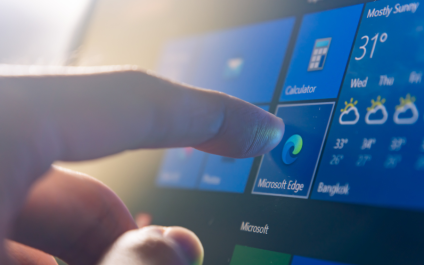

Although the Windows 10 operating system has been on the market for several years, many people are just now upgrading to Windows 10 from Windows 7 and other previous versions. Whether you just downloaded the software or have been using it since it first became available, here are some tips for troubleshooting common problems.
Windows Update Isn't Working
It's important to install Windows updates when they become available so you can take advantage of new features and protect your computer against known security threats. Whether you rely on automatic updates or update manually, you may have some issues completing the process. One of the most common problems is that you don't have enough disk space to install a major update. If you don't have at least 16GB of free space, move some of your personal files to a USB stick or external hard drive. Deleting temporary files may also free up enough space to complete the update.
If you receive a specific error code, run the Windows update troubleshooter. You can access the tool by following these steps:
- Select Start.
- Choose Settings.
- Click Update & Security-->Troubleshoot-->Additional troubleshooters.
- Select Get up and running-->Windows Update-->Run the troubleshooter.
- After the troubleshooter finishes running, restart your computer.
Problems with Windows Store Apps
You may also encounter problems with downloading, installing or using apps from the Windows Store. If you find that all the apps you need are missing or Windows 10 is displaying the wrong default apps, there are a few steps you can take to solve the problem.
First, run the Windows Store apps troubleshooter by pressing the Windows logo key and the letter I (as in ice cream) at the same time. Once the Settings pane opens, choose Update & Security-->Troubleshoot-->Additional troubleshooters. Select Windows Store Apps and click "Run the troubleshooter." Windows will automatically check for problems and attempt to fix any it finds.
If the problem persists, you may need to reset the Microsoft Store. Resetting the Microsoft Store will clear your data, but it won't delete any apps from your Microsoft account. Perform a reset by pressing the Windows logo key and the letter I at the same time, clicking Apps, selecting Microsoft Store, choosing Advanced options and then selecting Reset. Click Reset a second time for the changes to take effect.
Issues with the Windows 10 Search Box
If your Windows search box isn't working, check for updates first. After installing any available updates, restart your computer to make sure they take effect. If you still can't type in the search bar or have a related problem, run the Search and Indexing troubleshooter.
There are two ways to open the troubleshooter. If you don't have much technical experience, select Start-->Settings-->Update & Security-->Troubleshoot-->Find and fix other problems-->Search and Indexing. The other option is to use the command prompt. If you feel comfortable working with the command prompt, follow these steps:
- Press Windows logo key and R at the same time.
- Type "cmd" in the Open box and click OK.
- On the command line, type the following: msdt.exe - ep WindowsHelp id SearchDiagnostic
If running the troubleshooter still doesn't help, try restarting Windows Search. You'll need to follow these steps:
- Press Ctrl+Alt+Delete.
- Choose Task Manager.
- Click the Details tab.
- Find SearchUI.exe in the Name column, right-click on it and select "End task."
- Select "End process."
Windows Key Doesn't Work
You won't be able to install Windows 10 if you don't have a valid Windows product key. The product key is used to verify that you have a genuine copy of Microsoft Windows 10 and haven't exceeded the maximum number of installs included in the license. First, make sure you have a valid copy of Windows 10. If you downloaded the operating system from a non-Microsoft website, it may not be genuine. Second, make sure you have a stable internet connection. Finally, restart your computer and try activating the OS again.
Windows Key Doesn't Work
Windows 10 displays blue screen errors when something causes the operating system to restart or shut down suddenly. You may have heard these errors referred to as the "blue screen of death." CRITICAL_PROCESS_DIED, IRQL_NOT_LESS_OR_EQUAL and SYSTEM_SERVICE_EXCEPTION are some of the most common blue screen errors. If you see one of these errors on your screen, visit the Microsoft website to access step-by-step troubleshooting instructions.
Can't Connect to the Internet
If you can't connect to the internet, first make sure it's a Windows 10 problem and not a problem with your internet service. You can check for an outage by contacting your internet service provider or trying to connect on a different device. If you can't connect on any of your devices, the problem is likely caused by an internet issue and not a problem with Windows 10.
Next, check your Wi-Fi settings to make sure your Wi-Fi is turned on and you're connected to the right network. If you still can't connect, reboot your router and your modem.
Troubleshooting Help
If you don't feel comfortable troubleshooting issues with Windows 10 or the latest Windows version, Haycor Computer Solutions can help. One of our technical experts would be happy to adjust your default settings, help you back up your system files or troubleshoot problems related to your start-up settings, control panel, device manager or lock screen. We can also help you enable system restore, solve problems with your background apps or fix connectivity issues caused by limited internet bandwidth or outdated equipment. Call (905) 707-6775 or visit our website to send us a message.






